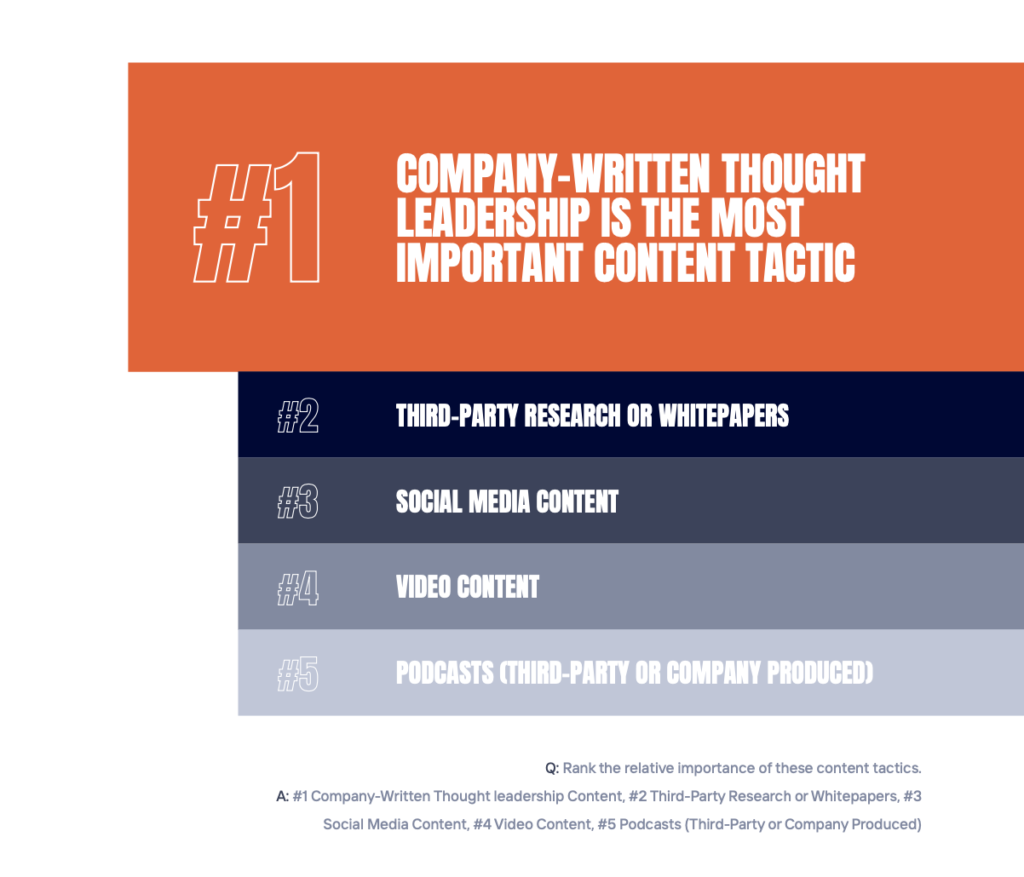Below is an excerpt from our 2022 Fintech CMO Survey Report, a deep dive into the opinions and mindsets of a wide range of senior fintech marketers. Over the next few weeks, as firms across the industry set their marketing budgets for 2023, we are highlighting some of the report’s key findings. Download the full report here.

While podcasts and video have their place, written fintech marketing content offers key advantages for a highly technical industry like fintech.
While there were once plentiful options for earned coverage, the contraction of the institutional fintech trade press has left fintechs fighting for attention in what has become an increasingly competitive media landscape. Companies have responded by increasingly looking inward, taking control of their message by boosting investment in marketing programs across the board. With this shift in philosophy, determining the most effective tactics is crucial.
Digital Content: Growth and Limitations
When it comes to getting key information across to clients and prospects, fintech marketers have a number of options at their disposal. The internet has upended the way consumers obtain information and interact with companies, and the avenues to reach them have multiplied as a result. But even with the choice of digital content options like podcasts and video, our survey revealed that firms still prize the power of the written word for fintech marketing, with our CMO respondents ranking company-written thought leadership content and third-party research or whitepapers ahead of video and podcasts in terms of importance.
Content Creation: Embrace the Written Word
Though there is mainstream discourse around the unwillingness of the average consumer to read an article in its entirety, our respondents clearly believe longform content remains an effective tactic in the fintech and capital markets marketing space. Over 50% of respondents noted that they plan to increase investment in thought leadership (both owned and paid placements) in 2022.
Though seemingly old-school in comparison to its flashier counterparts, this preference for the written word makes sense for an institutional audience, said Boucher (Instinet).
“For a sophisticated, niche audience like ours, which is both savvy and informed, leveraging only a traditional approach to sales has become significantly less effective,” said Boucher. “However, if you publish content that is value-adding, an institutional fintech audience will chase it; they like to hunt for information as and when they need it. We have found that this makes for a better brand experience and will often result in opportunities, and far less friction, in achieving direct contact.”
If you publish content that is value-adding, an institutional fintech audience will chase it; they like to hunt for information as and when they need it. We have found that this makes for a better brand experience and will often result in opportunities, and far less friction, in achieving direct contact.”
Lorna Boucher, Chief Marketing Officer & Global Head of Social Responsibility, Instinet
Text is easily skimmable and searchable, enabling consumers to get to the main idea or key data points much faster than they would combing through video or audio. This effect is magnified on social media, where accessibility, ease of viewing and ability to share make for a powerful combination. Likewise, the pandemic has effectively disrupted the once-daily morning commute and, by proxy, the need to pass the time with content that can be consumed on the go while en route to the office.
“Personally, if I click on a news article and the only way to get the information is by watching a video, 95% of the time I am closing the tab. Podcasts are also particularly hard to get right in a business context,” said CJ Lengua, Founder of Enimrac, a marketing consultancy focused on the institutional fintech space. “Written content is easier to chunk out. You can download and skim a PDF or read an email at your leisure.”
SEO for Content
It’s also important to keep in mind that longform articles continue to be more SEO-friendly content than podcasts or video. Search engines prioritize comprehensive, topic-focused written content. While audio or digital media descriptions can be optimized for search, they are ultimately too short to make an impact, necessitating an entire accompanying blog or detailed show notes, adding another step to the content production process.
With that, it’s no surprise that many fintech firms see the return on investment for written content as greater than that of podcasts or video. The latter formats require a significant investment of both time and money to produce, necessitating equipment, software and skill sets that ultimately make for a more complicated process. For an effective piece of written content, the process is far more information-centric.
Of course, the ideal medium can vary depending on the subject matter, the target audience and more. At the end of the day, it is the quality of the content that will attract clients and prospects.
“No matter the medium, you need to be able to meet people where they are, giving them the confidence and trust that your content is worth their time,” added Lengua.
Read on for our next blog recapping the next key highlight of our 2022 Fintech CMO Survey Report – why digital marketing tools are more valuable with support.